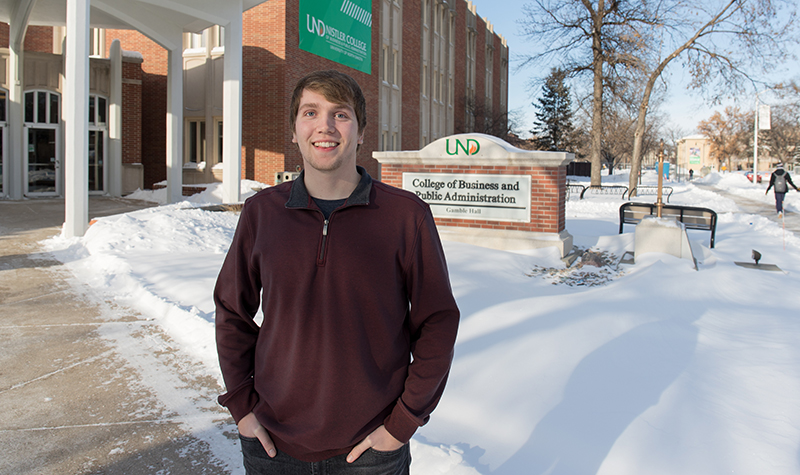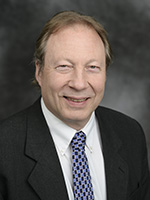15 Dec UND junior’s journey through Main Street GF Challenge, community partnerships takes small-town idea to next level

Junior and public affairs major Tyler Larson has worked tirelessly to create a new chapter for the teen hangout spot that he developed in his hometown of Harvey, N.D.: the Penny House. Photo by Connor Murphy/UND Today.
As a high school junior in Harvey, N.D., Tyler Larson caught himself saying the phrase that so many of his peers used as an excuse for their underage drinking: “There’s nothing to do.”
So Larson and his friends set out to give teens something to do that didn’t involve drinking and drugs. The result was the Penny House, a place where Harvey teens can socialize and have fun without the negative pressures common in adolescence. The video games, pool table, ping pong table and lounging spaces that Larson had envisioned are all there, and Harvey holds an annual fundraiser to pay the nonprofit’s bills.
“This is a marvelous place, run by kids, for kids, to give them something to do in our small town,” a reviewer says on the Penny House’s Facebook page.
Now Larson — a junior at the University of North Dakota — is well along in his next idea, which is to set up a Penny House in Grand Forks. After that, he’s thinking about a network of Penny Houses across the state.
First things first, though, because as the size of the community grows, the scope of the challenge does, too.
In other words, “Grand Forks is a whole other ball game,” Larson said with a laugh. “I could put up whatever in Harvey, and few would question it. You can’t really do that in Grand Forks.”
In Grand Forks, Larson essentially had to start from Square One. But he quickly found others who believed in his idea.
‘All over it’
Last year, Larson became one of the original winners of Evolve Grand Forks’ Main Street GF Challenge, which netted his Penny House idea a strong, early investment from the community. More important, it immediately expanded his network in Grand Forks.

Paul Sum
One of the people who spoke to the “Challengers” — the Challenge grant winners — was Paul Sum, professor in the Nistler College of Business & Public Administration at UND. Sum told the cohort about social entrepreneurship: developing social enterprises or innovative ideas to address social problems.
Afterward, Sum made an offer to the Challengers: he could be an effective link to the rest of the University and could offer credit hours for an internship. Larson was one of the students who jumped at the opportunity.
“He was really all over it,” Sum remarked.
As Larson arranged four “pop-up” Penny House events as opportunities for market research, he was regularly meeting with Sum. Larson now refers to the political science and public administration professor as a mentor.
Sum’s glad to have helped. “As Tyler was going through his learning process and pulling the project together, I was there to fill in the gaps and provide case studies and insights from the academic literature on running a social enterprise,” Sum said.
Throughout the fall of 2018, Larson made connections with Deek’s Pizza, Rock 30 Games and locations’ owners and managers to establish the Penny House pop-ups. Among the weekend-long locations that were set up, the one at Columbia Mall saw the best turnout, Larson said.
Keeping momentum
Funding from the Main Street GF Challenge helped Larson gain valuable information regarding the potential for a permanent Penny House. Then, his immediate plans changed when he decided to take an opportunity to study abroad.
Even while spending a semester in Norway to start 2019, though, Larson continued to develop the concept. By the time he was back in the states, he was ready to renew his internship with Sum and find new ways to fund the Penny House.
“It just made sense to keep working with Dr. Sum,” Larson said. “He’s been an invaluable source of information, contacts and encouragement.”
Sum brought Larson to the Center for Innovation, which opened Larson to the entrepreneurial side of campus.
“That quickly turned into all sorts of grant opportunities,” said Sum.
Larson earned a Mueller Internship as well as a grant stemming from this past fall’s Longest Table. All of the support confirmed that Larson was on the right track with the Penny House concept.
“His project pertains to one of the main things that came out of the Longest Table conversation this past year, which is young people need a place to go and something to do,” Sum continued.

Larson has helped lead both Longest Table events so far held in Grand Forks. Pictured here in 2018, donning a “table captain” cap, Larson was in the midst of arranging his first Penny House pop-ups under the guidance of Professor Sum and his Main Street GF Challenge advisers. Photo by Connor Murphy/UND Today.
By kids, for kids
Since receiving those grants, Larson established two more pop-ups to take place November and December. The first was on Black Friday weekend, with one day for middle school students and the other for high schoolers.
“That weekend went well,” Larson remarked. “Saturday, especially, was a huge success. We had students waiting outside the door before opening and had 30 kids there until we had to close. This was all despite the massive amount of snow we got that night.”
Columbia Mall is Larson’s ideal location for a permanent Penny House. It’s a place that teens frequent, parents feel is safe, and has a generally more secure and accessible setup than other venues. Additionally, Larson was able to maintain his connections to Deek’s and Rock 30 Games while bringing on the Grand Forks Virtual Reality Arcade, located at the mall, to provide VR goggles.
Overall, the atmosphere contributes to what Larson wants to see: local teens having a place to hang out, play games, talk, and generally let their guard down.
“Although the Penny House isn’t an after-school program, I believe that parents and the school district see the value in what we’re trying to do,” Larson said. “Working with the students to build an environment that feels safe and promotes healthy interaction has been identified by the Grand Forks community as something they would support.”
The next Penny House event is scheduled for Dec. 20 and 21, from 2 until 9 p.m. The Friday session will be open to middle school students, while Saturday’s will be open to those in high school.
Value of partnerships
Sum said he was confident that the Penny House will work its way into the fabric of the community. The project is healthy not only for Larson’s growth as an individual, but also for local youth, he added.
For his part, Larson said the path to the Penny House would have been a much “slower and rougher process” without the likes of Sum and the team at the Center for Innovation.
“Having support from them gives my project and myself a certain level of credibility,” he said. “It can break down some barriers when seeking new partners or contacts. The value that Dr. Sum puts into my project is indescribable.”
The partnerships Larson develops will be essential to the success of the model that’s worked so well in Harvey. As he strives to find a permanent home, he’s also developing a committee of students and adult members to govern the Penny House.
“Working with student organizations was the first step in the process, this year,” said Larson, who met with groups such as the Red River Game Club and Central High School’s Tech Club to generate engagement with the Penny House. “I learned that it’s so much more of an authentic and personal approach, and it seems to be a better way to do things.”

From perhaps penny-sized origins, Larson has striven for a network in Grand Forks that can take Penny House to a permanent location with a group of adult and teenage constituents invested in its success. Photo by Connor Murphy/UND Today.
Penny-sized origins
By the way, if you’re curious about where the Penny House got its name, it’s one more example of Larson taking a challenging situation and turning it into something meaningful.
By the time the first Penny House was taking shape, in late 2016, Larson was diagnosed with brain cancer. This meant that every few weeks, he went back and forth between Harvey and the Mayo Clinic in Rochester, Minn.
All the while, Larson was working through the final stages of the legal process — incorporating his nonprofit. The time had come to attach a name to the project, and it came first from his mother as he laid in a recovery bed.
In order to ascertain the nature of his cancer, doctors had to drill a penny-sized hole in his head.
“My mom said, ‘Why don’t you call it the Penny House?’” recalled Larson, who’s now cancer-free. “And it stuck.”


